The Camino de Santiago, or St. James Way in English, encompasses various pilgrimage routes culminating in Santiago de Compostela, Spain. Among these, the French Way (Camino Francés) is a highly popular choice, traditionally commencing in Saint-Jean-Pied-de-Port, France.
Alt text: Scenic dirt path of Camino de Santiago trail near Portomarín, Spain, ideal for biking.
Initially a religious pilgrimage centuries ago, the Camino has gained traction among modern travelers seeking adventure and respite from their demanding lives. While walking remains the prevalent mode of travel, cycling is rapidly gaining popularity.
Embarking on the French Way by bike presents a significant challenge. This route traverses approximately 800 km (500 miles) across northern Spain, showcasing a diverse range of terrains: dirt trails, paved roads, rocky descents, and even cow pastures.
During my trip planning, comprehensive resources for cyclists tackling the Camino were scarce. The internet and travel guides predominantly catered to walkers. This guide aims to bridge that gap, offering extensive information to assist you in planning your cycling expedition on the Camino de Santiago. These tips are drawn from personal experience; individual journeys may vary, and that’s perfectly normal.
Preparation for your French Way Bike Trip
Completing the French Way by bike is demanding and requires adequate preparation. Most experienced cyclists can finish the 800 km (500 miles) in about 11 to 14 days. The duration depends on your fitness level and desired pace, factoring in time for relaxation and exploration. I recommend a 13 to 14-day timeframe to allow for leisurely stops at local cafes and visits to attractions.
Averaging 57 km (35 miles) daily is necessary to cover 800 km in 14 days. The terrain includes hilly sections and two mountain range crossings, which we’ll discuss later. An “avid cyclist” in this context is someone who cycles two to three times weekly, covering around 40 km (25 miles) per ride.
With the right preparation, anyone can undertake this journey. Begin training at least 8 months prior to your trip, gradually increasing your cycling distance. Individual preparation needs differ, but for reference, my 8-month preparation involved cycling an average of 100 km (60 miles) weekly, sometimes 100 km on weekends alone. Even with this preparation, the Camino proved to be very challenging.
Why Choose the Camino Francés (French Way) for Biking?
The Camino Francés stands out as one of the most well-established trails globally. Navigation is straightforward, and ample infrastructure supports the numerous pilgrims walking and cycling annually. Despite sharing the path with many others, it retains an authentic, non-touristy feel.
The French Way exposes you to diverse cultures within Spain. While many embark on solo journeys, you’ll find camaraderie easily on the Camino.
Bike Logistics for the French Way
Let’s delve into the practicalities of bike arrangements. Two primary options exist for securing a bike at your starting point: shipping your own bike or acquiring one locally.
Shipping Your Own Bike to France/Spain
Shipping a bike from the US to Europe is generally the most expensive choice. While numerous international bike shipping services exist, they often utilize major carriers like UPS and FedEx, resulting in comparable pricing. Bikeflights.com is a well-known service in this sector.
Shipping costs encompass: bike box purchase, drop-off logistics, shipping fees, and pick-up at your destination.
Local bike shops can handle packaging and shipping, often delivering to another bike shop at your destination, potentially reducing costs compared to door-to-door service. However, consider the complication of ending your trip in a different location, necessitating return shipping arrangements.
Some cyclists prefer shipping their own bikes, viewing them as integral to their journey. If having your personal bike enhances your experience, this could be a worthwhile option.
Renting a Bike in France for the Camino
Alternatively, you can source a bike at your starting point. Renting or buying locally are the main options. For a two-week Camino trip, renting often proves more economical than international shipping. Key rental services catering to Camino cyclists include Bicigrino and Bikeiberia. While other companies exist, these two are frequently mentioned by cyclists on the route.
Bicigrino is highly recommended based on my experience. Despite a slightly clunky website, their service is excellent. While Spanish is preferred for email communication, they respond promptly. Bikes were delivered punctually to my Saint-Jean-Pied-de-Port accommodation, and return in Santiago was seamless.
Bicigrino provides comprehensive bike setups, including top-tier Ortlieb panniers, maintenance tools, and spare parts, even derailleur hangers. Fellow cyclists using Bicigrino also praised their service and bike quality. In 2015, they rented Specialized Crave bikes, well-suited for the Camino’s varied terrain.
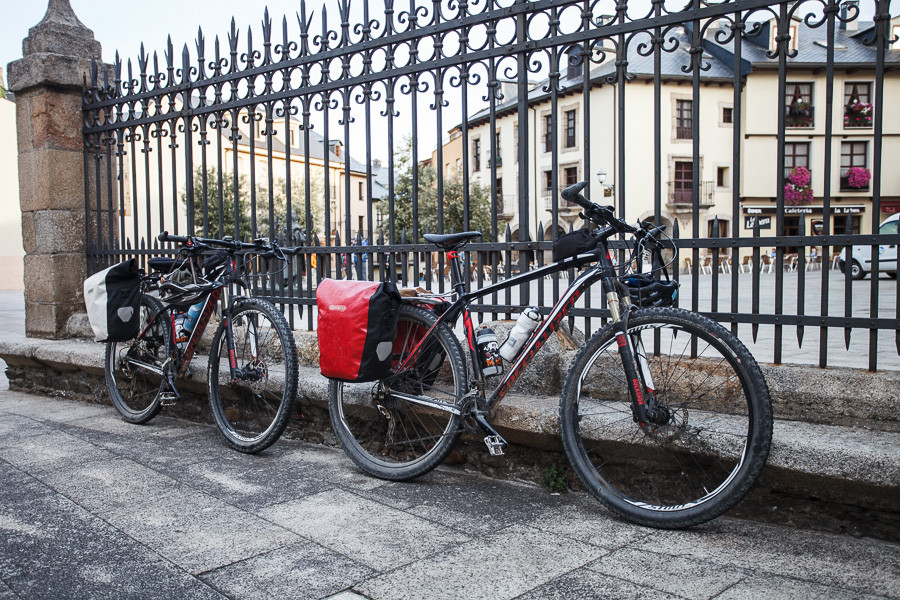 Rental Bikes from Bicigrino Alt text: Row of Specialized Crave rental bikes from Bicigrino ready for Camino cyclists in Saint-Jean-Pied-de-Port, France.
Rental Bikes from Bicigrino Alt text: Row of Specialized Crave rental bikes from Bicigrino ready for Camino cyclists in Saint-Jean-Pied-de-Port, France.
Besides rentals, purchasing a used bike in France or Spain is feasible. Cycling is popular in Europe, making used bikes accessible. However, consider resale or shipping logistics post-Camino. Renting generally remains the most convenient and cost-effective solution for biking the French Way.
Reaching Saint-Jean-Pied-de-Port: Your French Starting Point
While Saint-Jean-Pied-de-Port (SJPP) is the traditional French Way starting point, you can begin your Camino anywhere. For the classic French route, SJPP in France is the customary origin.
Small airports near SJPP include Biarritz in France and Pamplona in Spain. However, international connections might be limited. Many find it easier to fly into major airports and then travel to SJPP by train or bus.
For my trip, flying to Paris and taking a train to Bayonne, then a connecting train/bus to SJPP was most economical.
The fastest route from Paris to SJPP involves a high-speed train from Paris Montparnasse station. For travelers arriving at Charles de Gaulle Airport in Paris:
Arrive in Paris early for flexible travel options to Bayonne. Follow airport signs to the RER B station after baggage claim. The RER B train connects the airport to Denfert-Rochereau RER station, a short walk (15 min) from Montparnasse train station. The RATP website is a helpful resource for Paris public transport.
From Montparnasse, take a TGV high-speed train to Bayonne. Booking train tickets online in advance often yields significant savings, as on-the-spot purchases can be double the price for long-distance European train travel.
Once in Bayonne, proceed to the local train station and purchase a “train” ticket to SJPP. SNCF, the French train operator, offers a combined train and bus service to SJPP due to the lack of direct train lines. Request a ticket to SJPP, and the price covers both train and bus. The journey takes about 1 hour 15 minutes, including a train-to-bus transfer in Cambo Les Bains. Weekday services to SJPP are more frequent (3 departures) than weekends (2 departures).
Alternatively, experienced cyclists can bike from Bayonne to SJPP, a 52 km (32 miles) uphill ride.
Accommodation Options Along the Camino
Having addressed bike rentals and reaching Saint-Jean-Pied-de-Port, let’s consider accommodation choices on the Camino.
Albergues: Pilgrim Hostels
Camino albergues are unique dormitory-style accommodations, distinct from typical European hostels. They range from €0 (donation-based) to €15 per night. Donation-based albergues rely on pilgrim contributions, allowing travelers to pay what they can afford. Accommodation quality varies across albergues, regardless of price. Types include privately owned, government-run, and religious organization-operated albergues. Common rules include an 8 am departure time. Albergues operate on a first-come, first-served basis, though some reserve spots for later arrivals. Walkers generally have priority over cyclists due to cyclists’ greater mobility. Albergue quality ranges from basic to adequate, rarely exceptional. They are prevalent in towns and villages along the Camino.
Hostals: Family-Run Hotels
Hostals are akin to family-run hotels, offering rooms with private or shared bathrooms. Prices range from €20 to €50. Similar to albergues, price isn’t always indicative of quality. Good value hostals can be found for around €30-€40 for a double room, with varying bathroom arrangements.
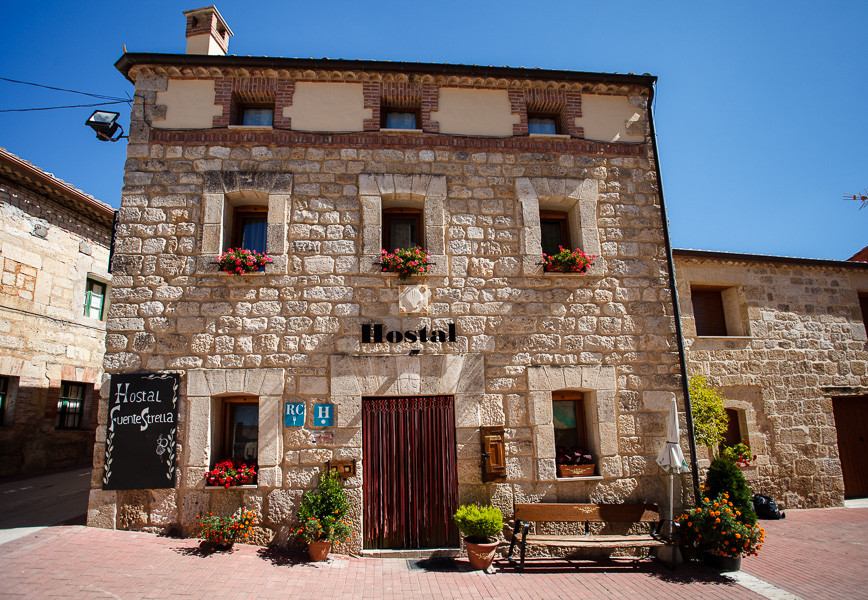 Hostal in Hontanas Alt text: Exterior view of a traditional stone Hostal in Hontanas, Spain, a common accommodation type on the Camino de Santiago.
Hostal in Hontanas Alt text: Exterior view of a traditional stone Hostal in Hontanas, Spain, a common accommodation type on the Camino de Santiago.
Casa Rural: Rural Bed and Breakfasts
Casa Rural, literally “rural home,” is the Camino’s version of a bed and breakfast. Expect simpler amenities than American B&Bs. Prices are similar to hostals, around €20-€40. Casa Rurales often offer excellent food.
Pension/Pension Rural: Apartments
Pensions and Pension Rural are buildings subdivided into apartments, typically with private bathrooms but lacking hotel-style services like a front desk.
Camping: Limited Options
Campsites are scarce on the Camino. Wild camping is possible but less appealing given the affordable albergue options (around €10 or less per bed).
Booking Accommodation on the Camino
Albergue beds are generally available on arrival, first-come, first-served. Calling ahead is advisable for other accommodation types. Many book accommodations a day or two in advance. Decide your daily cycling distance, select towns accordingly, and call a few places.
Booking.com is a useful platform for last-minute bookings in Europe, listing various independent properties (excluding albergues, but including other options). Many properties offer free cancellation up to the day before arrival.
Accommodation in Saint-Jean-Pied-de-Port
Finding accommodation in SJPP can be challenging. Advance booking is highly recommended, especially during peak season. While SJPP has traditional albergues, they fill up quickly. Booking ahead is wise, particularly as you’ll need to arrange bike delivery in SJPP.
 Accommodation in Saint-Jean-Pied-de-Port Alt text: Charming street in Saint-Jean-Pied-de-Port, France, showcasing typical Pyrenean town architecture and accommodation options.
Accommodation in Saint-Jean-Pied-de-Port Alt text: Charming street in Saint-Jean-Pied-de-Port, France, showcasing typical Pyrenean town architecture and accommodation options.
Bike Security on the Camino
Bike theft is generally not a major concern on the Camino. Basic precautions suffice. Most accommodations provide secure bike storage, though not always dedicated bike rooms. Exercise more caution in larger towns.
My bike remained unlocked about 90% of the time on my 13-day trip across Spain. Overnight storage locations ranged from hostal entrances to hotel server rooms, casa rural courtyards, gas station storage units, unlocked containers, and private garages. I never worried about theft. Removing valuables and luggage from your bike reduces risk, as these are more likely targets.
Food and Hydration on your Cycling Pilgrimage
Extensive food packing is unnecessary. Food and drink are readily available along the Camino. Carry extra water on hot days, but towns and villages are frequent, providing ample opportunities for meals and water refills.
Food and drink are integral to the Camino experience. Enjoy diverse culinary experiences, from traditional restaurant meals to budget-friendly bocadillos (sandwiches). Pack chocolate bars for energy boosts between towns.
Common Camino food options include:
Tortilla: Spanish Omelette
Tortilla, the Spanish omelette, varies from simple potato and egg versions to more elaborate chorizo and vegetable options. Widely available, tortilla is a good source of protein and carbs for cyclists.
Bocadillos: Sandwiches
Bocadillos, Spanish sandwiches, come in various forms and sizes. Ham and cheese is most common. Spanish cheese and jamón serrano (dry-cured ham) are distinct from standard deli fare. Customize your bocadillo with olive oil, tomatoes, or even tortilla.
Tapas: Appetizers
Tapas are bite-sized appetizers, showcasing diverse Spanish flavors. Common tapas include potatoes with various sauces, squid, octopus, and meatballs, served on bread or alone. In the Basque region, tapas are called pintxos, with locals asserting their distinctiveness.
Tapas offer a great way to sample multiple Spanish dishes in one meal.
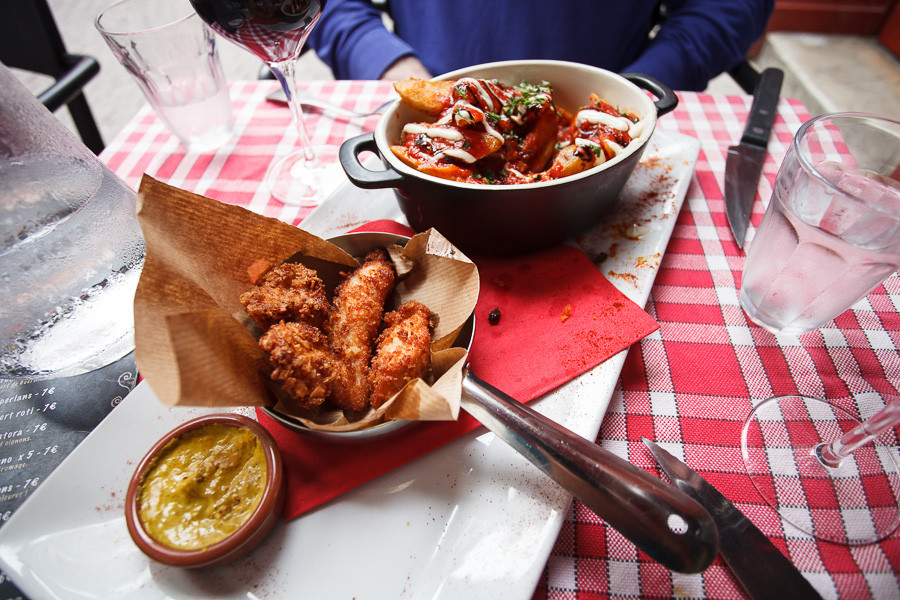 Chicken and Potato Tapas Alt text: Close-up of Chicken and Potato Tapas, a flavorful and varied appetizer commonly found on the Camino de Santiago.
Chicken and Potato Tapas Alt text: Close-up of Chicken and Potato Tapas, a flavorful and varied appetizer commonly found on the Camino de Santiago.
Great Meals on the Camino
Spanish cuisine is generally excellent. While tourist traps with overpriced average food exist, great meals are abundant. I enjoyed memorable sea bass in Roncesvalles, exceptional octopus in Galicia, and paella in Población de Campos. Sharing meals with fellow pilgrims enhances the experience. Cycling allows exploration for appealing dining options in towns.
Beer and Wine
Beer and wine are readily available. Bars for beer and tapas stops are plentiful, and wine is easily found to accompany meals.
Terrain on the French Way for Cyclists
The Camino terrain is varied: gradual and steep uphills, flats, rocks, loose gravel, paved roads, pastures. Most of the “official” path is unpaved but in decent condition. The initial stages, from Saint-Jean-Pied-de-Port to Pamplona via Roncesvalles, present the most challenging terrain, with boulders, sharp rocks, and mud, particularly crossing the Pyrenees.
Numerous sharp, short ascents can be difficult to pedal up. Pushing your bike uphill is common and acceptable. A 22T small front chainring is recommended for easier climbing. Many cyclists envied my bike’s low gearing. The Camino also includes flats and descents. A wide cassette is beneficial for both speed and climbing. The final 200 km (125 miles) are known for steep undulations.
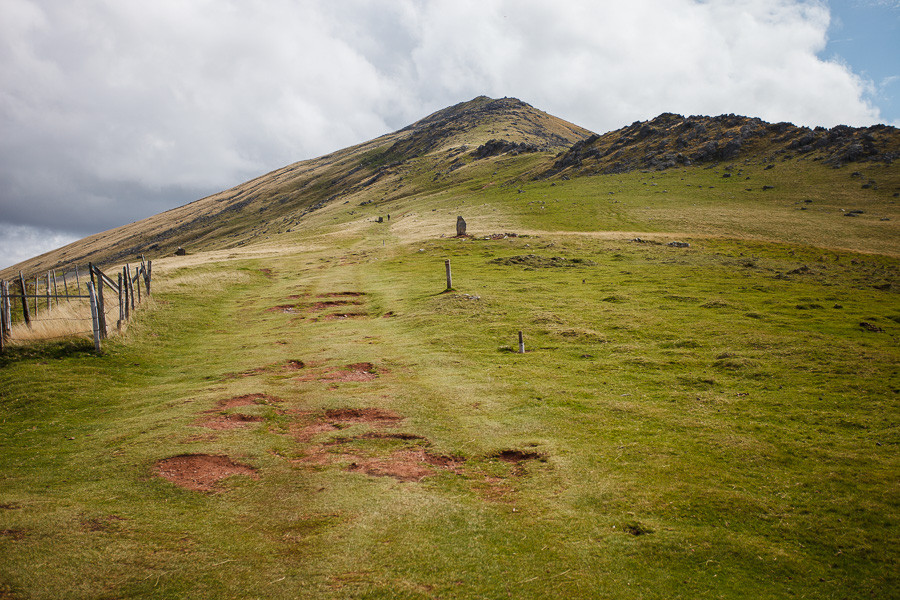 Grassy Fields Over The Pyrinees Alt text: Expansive grassy fields in the Pyrenees Mountains, showcasing the scenic but challenging terrain of the French Way.
Grassy Fields Over The Pyrinees Alt text: Expansive grassy fields in the Pyrenees Mountains, showcasing the scenic but challenging terrain of the French Way.
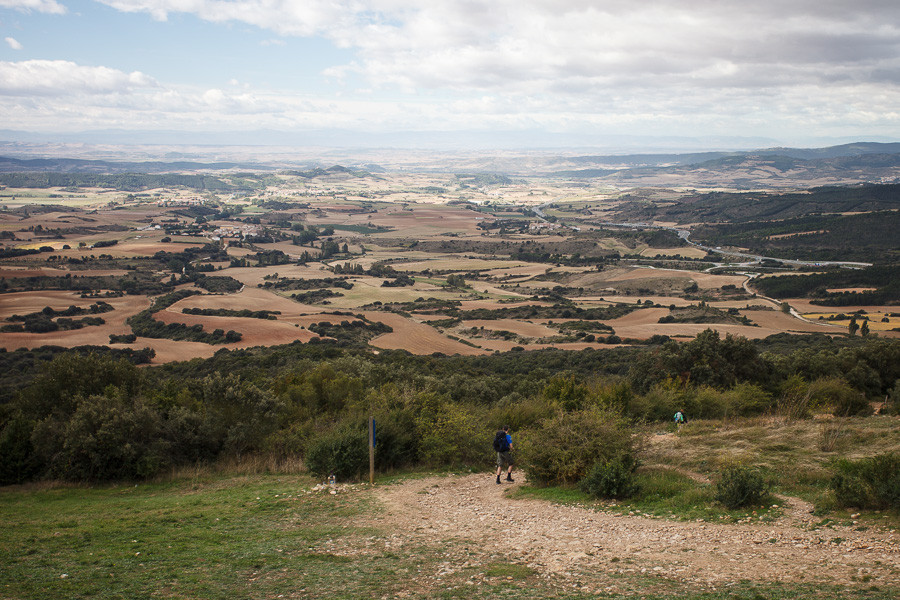 Loose Rocks Outside Pamplona Alt text: Rocky and uneven terrain with loose rocks on a section of the Camino de Santiago near Pamplona, indicating challenging biking conditions.
Loose Rocks Outside Pamplona Alt text: Rocky and uneven terrain with loose rocks on a section of the Camino de Santiago near Pamplona, indicating challenging biking conditions.
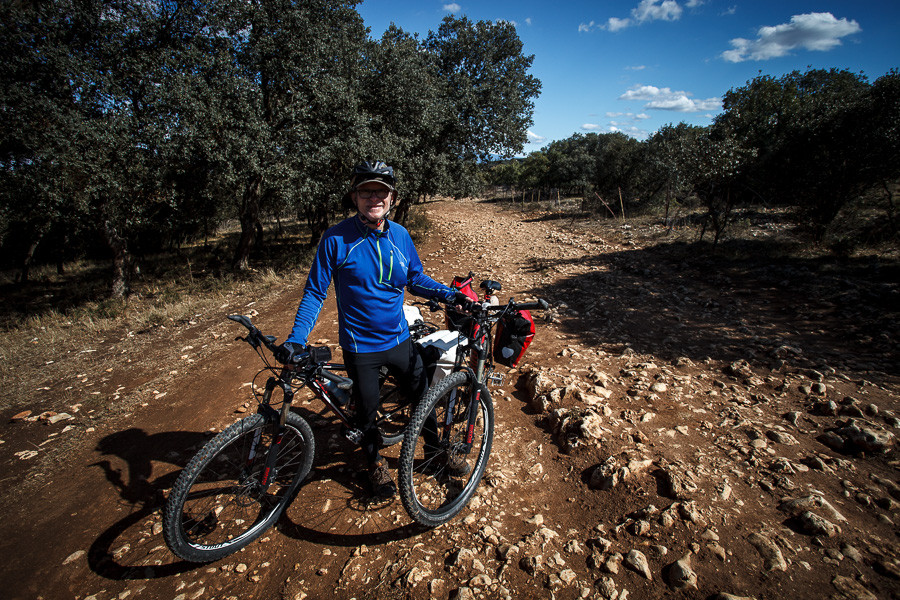 Rocky Section Close to Burgos Alt text: Very rocky and rugged section of the Camino trail near Burgos, highlighting the need for a robust bike and good riding skills.
Rocky Section Close to Burgos Alt text: Very rocky and rugged section of the Camino trail near Burgos, highlighting the need for a robust bike and good riding skills.
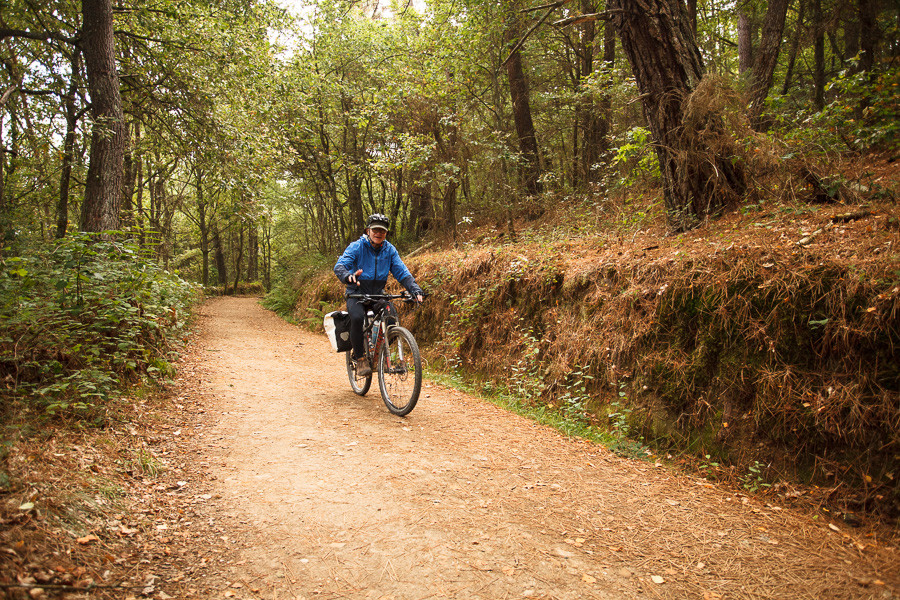 Typical Dirt Path in Galicia Alt text: Example of a typical dirt path in Galicia, Spain, illustrating a more moderate and rideable terrain type on the Camino.
Typical Dirt Path in Galicia Alt text: Example of a typical dirt path in Galicia, Spain, illustrating a more moderate and rideable terrain type on the Camino.
Daily Costs on the French Way
Average daily costs can be categorized into:
-
Super Low Budget Pilgrim: (€16 – €24 daily)
- Albergue: €8 – €12
- Food supplies: €8 – €12
-
Somewhat Thrifty Traveler: (€30 – €57 per person daily)
- Casa Rural/Pension/Hostal: €15 – €40 (double room)
- Breakfast: €5 – €8
- Lunch: €5 – €12
- Dinner: €8 – €12
- Trail supplies: €5
-
All-Out Rich Man: (Variable, high cost)
- Regular Hotel/Parador: €70 – €400+
- Breakfast: €10+
- Lunch: €12 – €20+
- Dinner: €12 – €50+
My average daily cost was around €40.
Navigation on the French Way by Bike
Navigation on the Camino Francés is remarkably simple. Follow the ubiquitous yellow arrows. Despite initial skepticism, the arrows are consistently present. A road map is useful for alternative routes.
 Yellow Arrow Marking the Way Alt text: Bright yellow arrow painted on a stone, clearly marking the Camino de Santiago route for pilgrims.
Yellow Arrow Marking the Way Alt text: Bright yellow arrow painted on a stone, clearly marking the Camino de Santiago route for pilgrims.
The Camino is primarily a walking path, and some sections are less bike-friendly. A road map is advisable for detours. I estimate I followed 80% of the official walking path, opting for bike-friendly roads for the remaining 20%.
Use guide maps and GPS apps to assess path suitability for biking. If a section seems unsuitable, choose a nearby road. If road detours are too extensive, staying on the walking path may be preferable to maintain the Camino experience.
Exercise judgment and choose the best approach for you. There is no single “correct” way to travel the Camino.
Resources for Biking the French Way
Guides
- A Village to Village Guide to Hiking the Camino De Santiago: Camino Frances: St Jean – Santiago – Finisterre (Guide used by the author)
- A Pilgrim’s Guide to the Camino de Santiago: St. Jean > Roncesvalles > Santiago (Popular guide among pilgrims)
Apps
- OsmAnd (Mapping app with free offline maps)
Bike Rental Services
- Bicigrino (Service used by the author)
- Bike Iberia (Another rental service mentioned by pilgrims)
Affiliate Links
Using the provided affiliate links supports the website at no extra cost to you. Purchases made through these links earn the website a small commission. These relevant links are placed at the page bottom to maintain website clarity.

